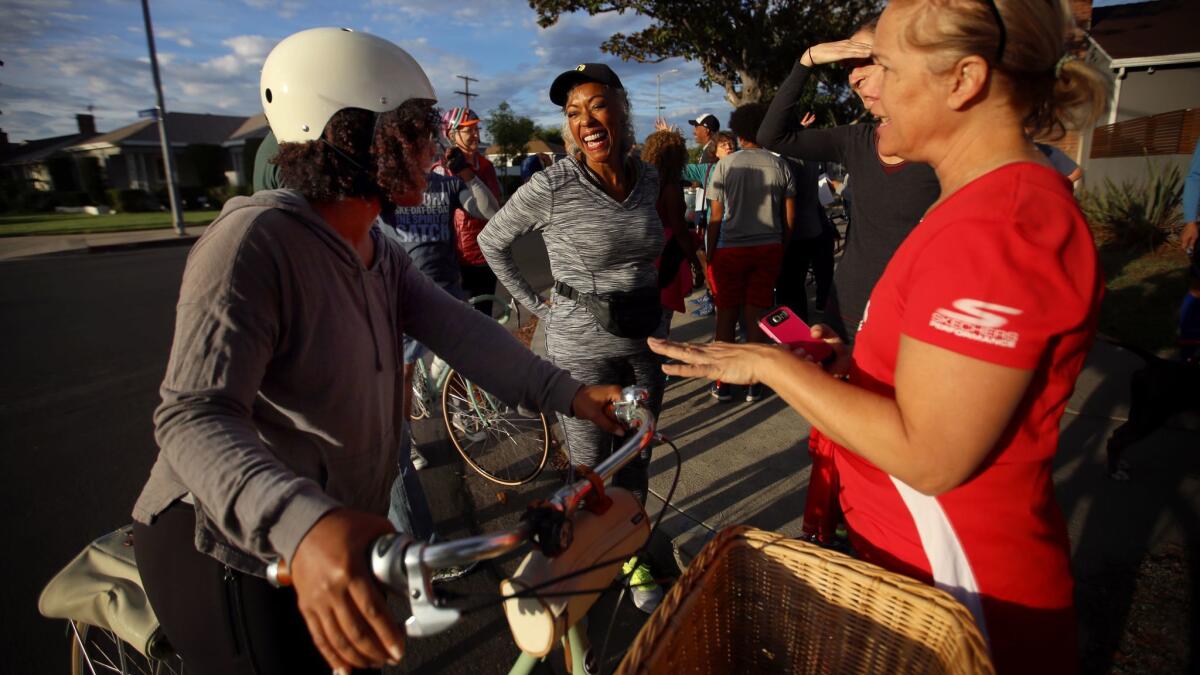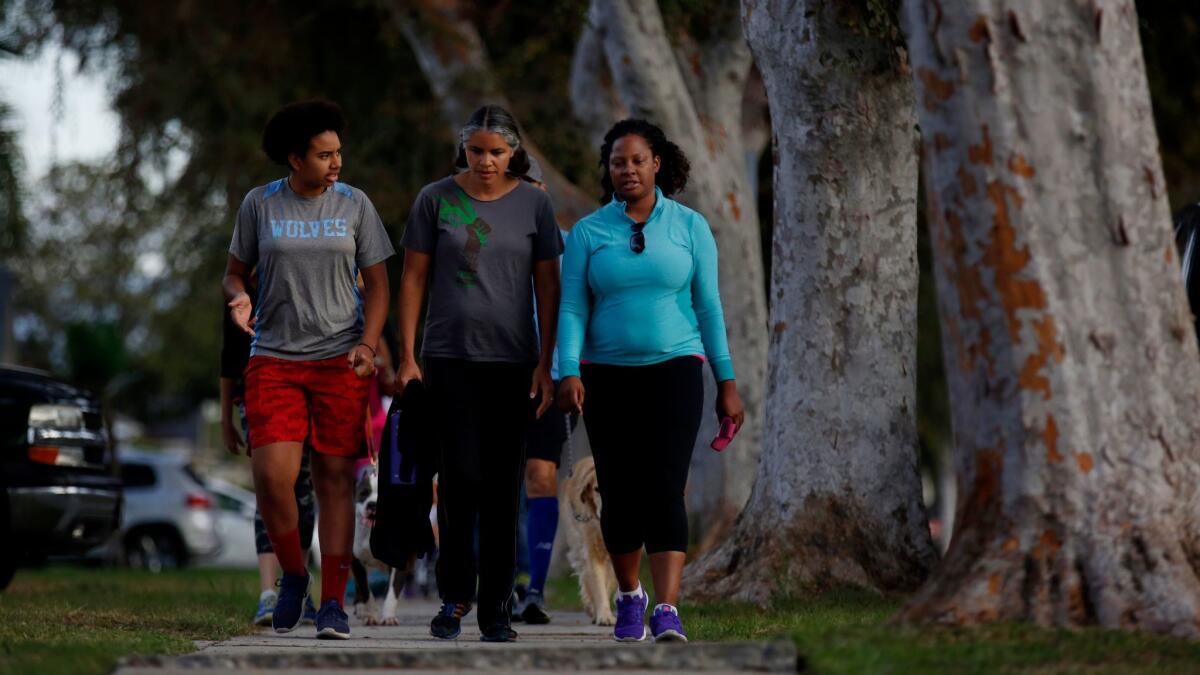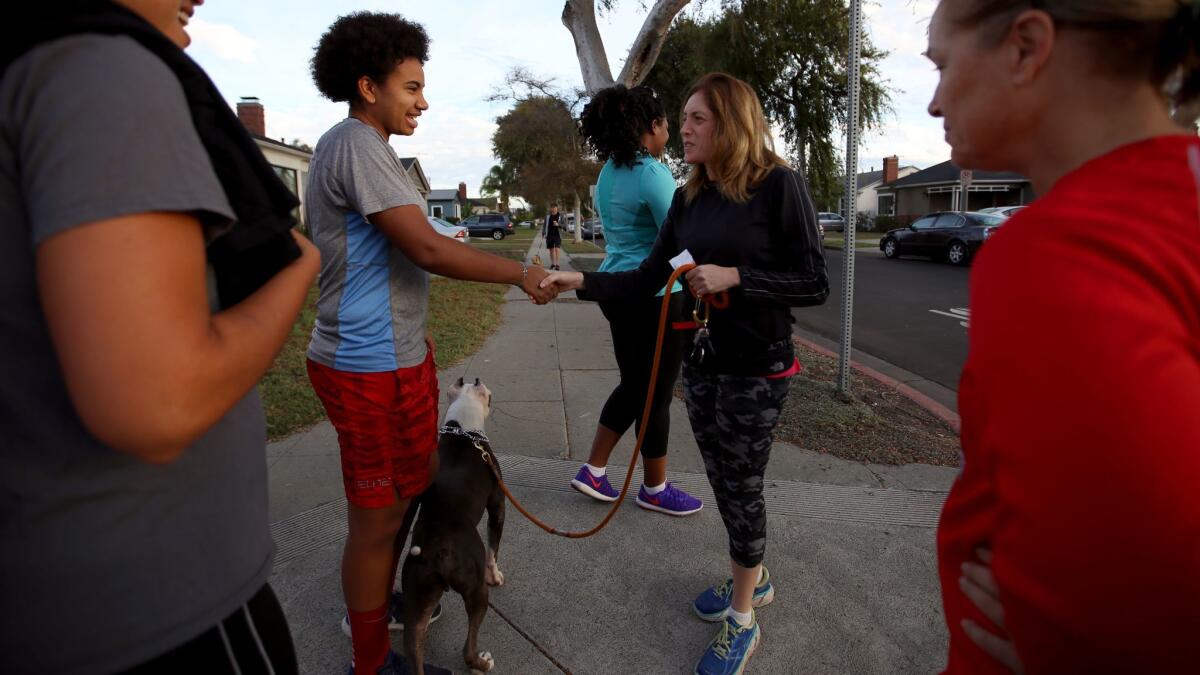Selfie of white joggers in African American neighborhood sets off debate, and quest for understanding

It’s the selfie that set off a gentrification debate.
- Share via
It was the selfie that set Leimert Park talking.
There was DeMille Halliburton, his arm outstretched in the foreground, shooting a photo of the Saturday running group the African American entertainment industry insurer has long organized.
Behind him stood eight white neighbors, smiling under a sunny sky, a few holding on to their dogs’ leashes. Tucked in the very back were two black runners.
The photo Halliburton uploaded that day in October set off a storm of debate in Leimert Park, a middle-class, traditionally African American neighborhood.
The photo generated numerous comments on social media, with many expressing concerns about what they saw as the neighborhood’s changing demographics. For some blacks, the photo was a symbol of how they were losing clout in the neighborhood amid rising home values.
Another image sparked similar Internet debate. A resident posted a picture from the Baldwin Hills Crenshaw Plaza shopping center’s website showing four white women piled in a car, presumably going to or coming from the mall.
Los Angeles’ African American population has been declining for more than two decades. Latinos now make up the majority in many working-class South L.A. neighborhoods. Leimert Park, nestled at the foot of the Baldwin Hills, has long been home to many of L.A’s African American elites. It’s seeing big changes, with two new light rail lines running through and interest from whites priced out of neighborhoods to the north.
“It’s almost like Leimert Park is the last battleground,” said Earl Ofari Hutchinson, president of the Los Angeles Urban Policy Roundtable. “It’s the last piece of turf that African Americans can really call and really feel is their home. At this point in time, it’s being encroached upon.”

The running club photo does not exactly reflect the district’s demographics.
Today, Leimert Park continues to have one of the highest concentrations of black people in the city — 70%, down from the height of the 83% in the 1980s. White families currently make up about 2% of the neighborhood, a statistic in sharp contrast to the fleeting moment captured by Halliburton’s photograph.
“In this case, a picture misrepresents a thousand words,” Hutchinson said.
When he looks at the picture, he sees runners, he said. And in his own experience, Hutchinson said, running seems to be more popular among whites as a pastime than blacks.
But while the statistical change remains small, many residents say they are seeing greater diversity in the area.
Halliburton has lived in Leimert Park for 12 years and says he has seen his all-black block gradually shift as four white new families moved in.
“That’s just my little block,” he said. “Sporadically, I will see a new young family with their stroller and dog in the neighborhood.”
Halliburton said he was jogging with a neighbor last year at Leimert Park Village when a black man said loud enough for them to hear, “Get out of my neighborhood.”
The missive was directed at Halliburton’s neighbor, who is white.
Halliburton stopped, flabbergasted, and said, “Excuse me. This is our neighborhood too.”
The man went silent, Halliburton said.
“There are some real fears and anxieties about losing what people think they have,” said Halliburton, who added that he has been called an “Uncle Tom” and a “sellout” for “chum[ming] with the white folks.”
Halliburton found himself embarrassed, and in an unexpected position of having to comfort his white neighbor.
His neighbor brushed it off, saying: “It’s going to take time.”
Carl Pfirman, a recent arrival to Leimert Park who is white, said he has experienced similar hostile confrontations at Leimert Park Village and now skips that loop during the weekly run. He joined the running club, which now also welcomes walkers, in part because he wanted to be a good neighbor. But Pfirman said he was surprised by the uproar over the photo.
“I was pretty upset,” he said. “I don’t want to change the flavor of the neighborhood. I see my face there and I don’t want to be part of that, but I am. We need to talk. I don’t know what’s the solution.”
At the core of the racial tension is the economic frustration of a generation of black residents like 39-year-old Jamal Jones. Jones lived in the area during some dark years — riots, crime, drug woes — but fears he might not reap the benefits now that the area is experiencing a rebirth.
In the years after the 1992 Rodney King riots, gang violence, a scarcity of basic amenities such as quality grocery stores and sit-down restaurants and an overall lack of investment in the community drove black families out, to Lancaster, San Bernardino and Riverside. Jones’ parents moved the family to Lynwood and then Ontario. They would visit his grandfather in Leimert Park on the weekends.

Some of those who weathered the hard times now find themselves unable to afford the rising rents and higher home prices. According to Redfin, the median home price has more than doubled in the last seven years from $250,000 in 2009 to $503,750 in 2016.
“This community was decimated,” Jones recalled. “Now it’s coming up, and it’s improved and not everybody is going to be able to enjoy it. Leimert residents have been begging for these investments for years …. Is this for us?”
N.D.B. Connolly, an associate professor of history at Johns Hopkins University in Baltimore, said African Americans have been disproportionately affected by de facto segregation that made it harder for them to accumulate wealth than whites. Policies like redlining — where banks refused to issue loans to communities of color — and predatory home loans continue to have a lasting impact on generational wealth, he said.
“At no point in American history has a majority of black Americans owned their own homes,” Connolly said.
Leimert Park has long been an entry point to homeownership and a comfortable living for the black middle and working class. It does not boast a stock of historic mansions like its northern neighbor, West Adams, or the panoramic views atop Baldwin Hills. But its stable mix of single-family homes on large and small lots attracted an emerging class of black elites who found it accessible and affordable, including former mayor Tom Bradley and singer Ray Charles.
The neighborhood was not always a haven for blacks. Up until the 1950s, the area was occupied by white families.
But they fled as black residents moved in.
Tens of thousands of whites left Leimert Park, Baldwin Hills and other South Los Angeles neighborhoods. The first wave left in the years after the Supreme Court invalidated white-only real estate covenants in 1948. Then another, larger exodus happened after the 1965 Watts riots.
The 1992 riots further battered Leimert Park. But in recent years, it has begun to see better times, and with that has come a growing sense of pride among black residents.
Leimert Park is home to a thriving Afrocentric arts community and commercial corridor thoroughfare along Crenshaw and Degnan boulevards.
On Sundays, an African drum circle still meets in the triangle-shaped neighborhood square in Leimert Park Village. Afrocentric knick-knacks are sold in boutique stores. The park remains a place where residents come to grieve and heal when tragedy strikes the black community, such as they did during the 1992 riots.

For some black residents, the neighborhood’s ascent — and the subsequent interest from the outside — is happening even as there are fewer black people to enjoy it.
“It’s like a slap in the face for the people that live there,” Carlton Manuel, 51, said. He said he called Leimert Park home for half his life but has recently been priced out of living there. The “services are getting better — the roads are getting taken care of, you are seeing more development, the Metro — but you’re losing the culture.”
County Supervisor Mark Ridley-Thomas, a longtime Leimert Park resident, said these fears are not representative of the entire community. Property owners are happy to see their home values rise. Other residents are excited for new amenities in their neighborhood.
The uproar over the photos has spilled over into packed community rooms where residents have candid conversations about gentrification and try to brainstorm ways to preserve the character of their neighborhood.
And the running group grew bigger and stronger. More people are coming out to join the club and Halliburton, the group’s leader, said it was adding a weekday meet-up.
Pfirman, the jogger, attends many of these meetings. The film editor said he listens more than he speaks to gain a better understanding of his neighbors’ frustrations.
“People need to think about that,” he said. “The anger comes from someplace.”
After the group’s runs, they meet at a Starbucks for frank conversation. On a recent Saturday, the members of the club talked about things like police use of force, politics and socioeconomic factors that have historically placed blacks at a disadvantage for acquiring wealth.
As he usually does during these talks, Pfirman leaned in and listened.
For more California breaking news, follow @AngelJennings. She can also be reached at angel.jennings@latimes.com.
Staff writer Sandra Poindexter contributed to this report.
MORE LOCAL NEWS
Two injured in latest shooting on San Francisco-area freeway
Justice Sotomayor laments perception of judges as political
The Marines’ plan to save California desert tortoises includes ‘raven no-fly zones’ and laser guns
Garcetti bans private meetings between developers and planning commissioners
More to Read
Sign up for Essential California
The most important California stories and recommendations in your inbox every morning.
You may occasionally receive promotional content from the Los Angeles Times.














